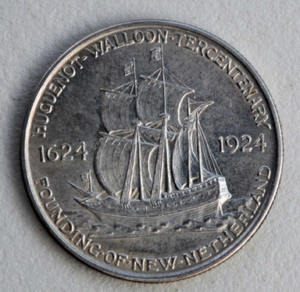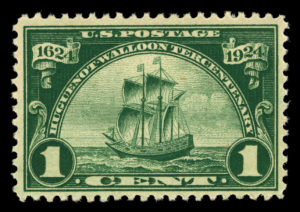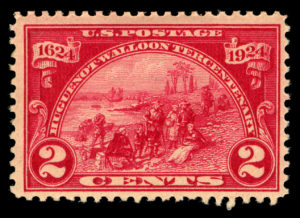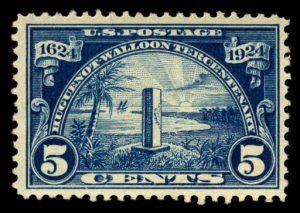New Netherland Pilgrims
¶ 1 Leave a comment on paragraph 1 0 In 1924, the Huguenot-Walloon New Netherland Commission organized a series of events in New York to celebrate the first permanent settlement of Huguenots on American soil and the founding of New Netherland and wanted to share the story of their ancestors by pursuing a commemorative stamp series. Framing the founding of New Netherlands as the “Huguenot-Walloon” anniversary was contested at the time. the Dutch, including Henry Hudson, fur trappers and merchants from the West and East India Companies were commonly seen as the founders of New York. The Commission highlighted the settlement of Walloon families, who were French-speaking Protestants from Belgium who had settled in Holland, and obscured the role of the Dutch government and its entities in their settlement story. Anniversary literature identified the Huguenot-Walloons as pilgrims, who were persecuted for their religious beliefs like those who landed near Plymouth. Formed by the Federal Council of the Churches of Christ in America, the commission worked to make the Walloon’s history visible to all Americans, because their “advent marks a new epoch in the history of both Church and State.” Obtaining a set of commemorative stamps, and a coin, performed some of that work, and acknowledged the Walloons arrival as significant episode in the American past. ((“Huguenot-Walloon New Netherland Celebration”, Huguenot-Walloon New Netherland Commission, 1624-1924, Program (New York, 1924)))
¶ 2 Leave a comment on paragraph 2 0 The Commission understood the challenges they faced educating Americans about their history. After the release of this commemorative stamp series, a few collectors wrote to the Postmaster General puzzled by the subject of the series and questioned the significance of those events. One collector begged for a short bibliography about the Huguenots or Walloons, because “all of the histories I have at hand seem to be a bit deficient in matters relating to the events these stamps commemorate. Collectors and citizens occasionally questioned the criteria that qualified an event or subject as nationally-significant, and worthy of printing on a commemorative. According to the post office, this anniversary was “of more than ordinary interest particularly in those sections of the country where these colonists originally settled.” ((Stamp Design Files, National Postal Museum (hereafter cited as Design Files), #614-616: Ruth Hawes, “Letter to Post Office Department,” August 25, 1924; J.D. Riker, “Letter to Post-Master General of the United States,” June 18, 1924; Lois D. Williams, “Letter to Post Office Department,” July 21, 1924. Irwin Glover, “Letter to James R. Fraser,” letter, January 9, 1925; Gisle Bothne, “Letter to Postmaster General Harry S. New,” letter, December 10, 1924; Carl G. O. Hansen, “Letter to Mr. Harry S. New,” letter, December 10, 1924.))
¶ 3
Leave a comment on paragraph 3 0
 Huguenot-Walloon Tercentenary Commemorative Silver half dollar (1924, eBay)The silver half-dollar coin, minted by the Commission, included the phrase “Founding of New Netherland” below the announcement of the “Huguenot-Walloon Tercentenary, 1624-1924” alerting those purchasing the commemorative coin of the significance of the celebration. The stamp series, however, was not well described in print, baffling collectors and citizens confronted with the Huguenot-Walloon issues.
Huguenot-Walloon Tercentenary Commemorative Silver half dollar (1924, eBay)The silver half-dollar coin, minted by the Commission, included the phrase “Founding of New Netherland” below the announcement of the “Huguenot-Walloon Tercentenary, 1624-1924” alerting those purchasing the commemorative coin of the significance of the celebration. The stamp series, however, was not well described in print, baffling collectors and citizens confronted with the Huguenot-Walloon issues.
¶ 4
Leave a comment on paragraph 4 0
 Huguenot-Walloon Tercentenary, 1-cent, 1924 (Photo, National Postal Museum Collection)
Huguenot-Walloon Tercentenary, 1-cent, 1924 (Photo, National Postal Museum Collection)
¶ 5 Leave a comment on paragraph 5 0 Deciphering these stamps proved challenging for all, without readily-identifiable images. On the 1-cent issue, the Nieu Nederland sailed in 1624 east towards America, and families landed in the 2-cent stamp with no visual aide indicating where the ship sailed from, where it landed, or who the Huguenot-Walloons were.
¶ 6
Leave a comment on paragraph 6 0
 Huguenot-Walloon Tercentenary, 2-cent, 1924 (Photo, National Postal Museum Collection)
Huguenot-Walloon Tercentenary, 2-cent, 1924 (Photo, National Postal Museum Collection)
¶ 7 Leave a comment on paragraph 7 0 The third stamp in the series is even more cryptic, picturing an unnamed monument facing a rising sun in what appears to be a tropical climate. Palm trees and plants surrounding the structure contrast with the rocky, sparsely-planted landscape pictured in the 2-cent settlement stamp. The 5-cent issue actually represents a stone monument erected by Jean Ribault who explored the area near Mayport, Florida, in the 1560s to establish a refuge colony for French Huguenots. Before returning to France to pick up passengers for the sail back to Florida, Ribault erected a stone column festooned with the French King’s coat of arms to claim Florida in the name of France. As part of the Huguenot-Walloon anniversary in 1924, the Florida Daughters of the American Revolution chapters financed the building of a similarly-shaped monument to honor Ribault and the “first landing of Protestants on American soil.” ((Roger Brody, “Huguenot-Walloon Tercentenary Issue,” Arago: People, Postage and the Post (Washington, D.C.: National Postal Museum, May 16, 2006), http://www.arago.si.edu/index.asp?con=1&cmd=1&mode=1&tid=2033829&. For plaque text see photo of the monument Shannon McCann, “Brown on White on Flickr – Photo Sharing!,” When Lost In…, March 19, 2008, http://www.flickr.com/photos/whenlostin/2743408241/in/photostream/. Interestingly, the memorial to the Walloons erected in Battery Park during the 1924 tercentennial, does not mention their religion or status as persecuted religious refugees.))
¶ 8
Leave a comment on paragraph 8 0
 Huguenot-Walloon Tercentenary, 5-cent, 1924 (Photo, National Postal Museum Collection)
Huguenot-Walloon Tercentenary, 5-cent, 1924 (Photo, National Postal Museum Collection)
¶ 9 Leave a comment on paragraph 9 0 The Huguenot-Walloon Tercentenary committee specifically wanted the memorial commemorating Jean Ribaud’s settlement to appear on a stamp representing the first Protestant settlement in America. Seeking to redefine the chronology and attribution of religious tolerance in colonial America, they claimed that the Huguenot Walloons brought with them a strong commitment to religious tolerance that “neither Pilgrim nor Puritan possessed.” Descendants of Huguenots and Walloons desired the stamps and the celebration to counteract the “forgetfulness” of the “names and race of its founders” due to lost records. ((The Huguenot-Walloon New Netherland Commission and Antonia H. Froendt, The Huguenot-Walloon Tercentenery (New York, 1924), available in HathiTrust: http://catalog.hathitrust.org/Record/006829950.)) With the endorsement of the federal government, this stamp series helped the anniversary committee to make a claim on New York’s colonial history and positioned the Walloons among America’s earliest religious pilgrims.
Comments
0 Comments on the whole Page
Leave a comment on the whole Page
0 Comments on paragraph 1
Leave a comment on paragraph 1
0 Comments on paragraph 2
Leave a comment on paragraph 2
0 Comments on paragraph 3
Leave a comment on paragraph 3
0 Comments on paragraph 4
Leave a comment on paragraph 4
0 Comments on paragraph 5
Leave a comment on paragraph 5
0 Comments on paragraph 6
Leave a comment on paragraph 6
0 Comments on paragraph 7
Leave a comment on paragraph 7
0 Comments on paragraph 8
Leave a comment on paragraph 8
0 Comments on paragraph 9
Leave a comment on paragraph 9